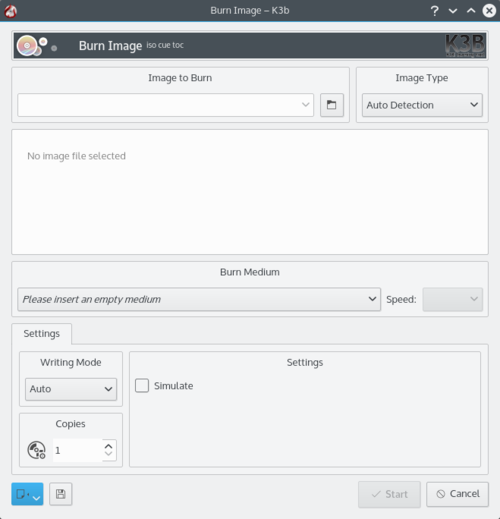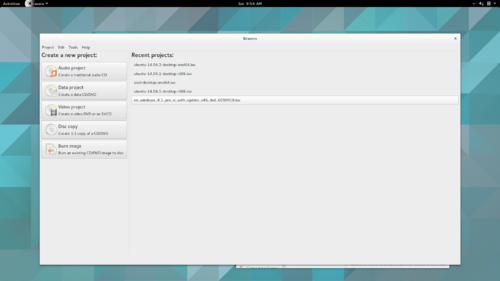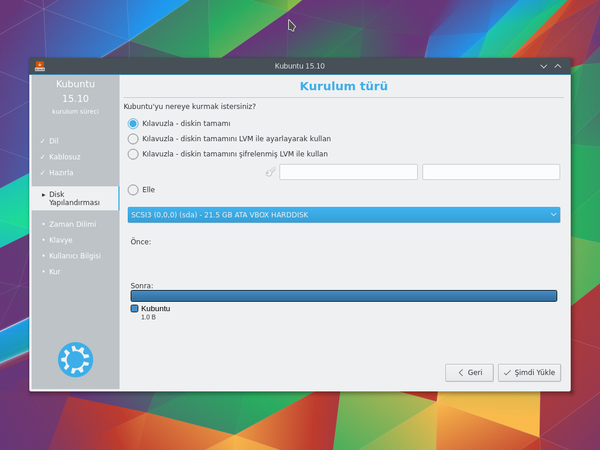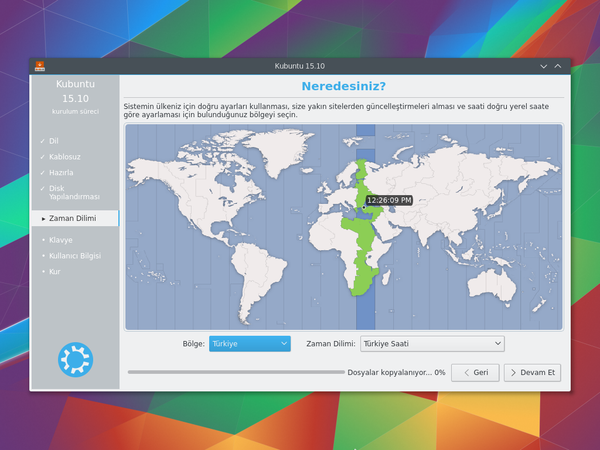Kubuntu/Installation/tr: Difference between revisions
Created page with "{{Note/tr|Seçili kurulum ortamından önyükleme yapabilmek için klavye üzerinde özel bir tuşa basmanız gerekecektir. Örn.: Esc, F2, F10, F12 veya Del. Bu tuş üretici..." |
Updating to match new version of source page |
||
| Line 15: | Line 15: | ||
=== MD5SUM Doğrulama === | === MD5SUM Doğrulama === | ||
Bunu yaparak, indirme işleminin başarılı olduğunu ve tamamen çalışan, önyüklenebilir bir ISO dosyası edindiğinizden emin kılar. | Bunu yaparak, indirme işleminin başarılı olduğunu ve tamamen çalışan, önyüklenebilir bir ISO dosyası edindiğinizden emin kılar. | ||
==== Windows XP -> 7 -> 8 -> 10 sürümlerinden ==== | ==== Windows XP -> 7 -> 8 -> 10 sürümlerinden ==== | ||
Microsoft Windows does not have any built in tools for MD5SUM but they do provide <!--- DEAD LINK! some [https://support.microsoft.com/en-us/kb/841290and decent documentation] --> [http://www.microsoft.com/en-us/download/details.aspx?id=11533 a tool] for checking the MD5SUM. How-To-Geek also provides some [http://www.howtogeek.com/67241/htg-explains-what-are-md5-sha-1-hashes-and-how-do-i-check-them reading material] | Microsoft Windows does not have any built in tools for MD5SUM but they do provide <!--- DEAD LINK! some [https://support.microsoft.com/en-us/kb/841290and decent documentation] --> [ DEAD LINK http://www.microsoft.com/en-us/download/details.aspx?id=11533 a tool] for checking the MD5SUM. How-To-Geek also provides some information regarding MD5SUM [http://www.howtogeek.com/67241/htg-explains-what-are-md5-sha-1-hashes-and-how-do-i-check-them reading material] | ||
==== From Mac OS X ==== | ==== From Mac OS X ==== | ||
| Line 30: | Line 30: | ||
<code>md5 /PATH/kubuntu-15.10-desktop-amd64.iso</code> | <code>md5 /PATH/kubuntu-15.10-desktop-amd64.iso</code> | ||
output would be: | The output would be: | ||
<code>MD5 (/PATH/kubuntu-15.10-desktop-amd64.iso) = 2e9967a25d87f7c685c63101eddb17d6</code> | <code>MD5 (/PATH/kubuntu-15.10-desktop-amd64.iso) = 2e9967a25d87f7c685c63101eddb17d6</code> | ||
| Line 38: | Line 38: | ||
==== From Ubuntu Linux ==== | ==== From Ubuntu Linux ==== | ||
The first thing to do is to make sure you're in the directory with the .iso file (most likely in the Downloads directory). Then run the command 'md5sum': For more | The first thing to do is to make sure you're in the directory with the .iso file (It will most likely be found in the Downloads directory). Then run the command 'md5sum': For more a more detailed explanation of MD5SUM: [https://help.ubuntu.com/community/HowToMD5SUM ] | ||
md5sum kubuntu-15.10-desktop-amd64.iso | md5sum kubuntu-15.10-desktop-amd64.iso | ||
| Line 46: | Line 46: | ||
====USB/Flash Drives==== | ====USB/Flash Drives==== | ||
For a GUI (Graphic User Interface) we use [http://unetbootin.sourceforge.net/ UNetBootin]. | For a GUI (Graphic User Interface) we use [DEAD LINK http://unetbootin.sourceforge.net/ UNetBootin]. | ||
You can use UNetBootin to download the ISO(image file) | You can use UNetBootin to download the ISO(image file) automatically or it can be downloaded here: [DEAD LINK http://www.kubuntu.org/getkubuntu/download Get Kubuntu]. | ||
If you choose the 'Diskimage' option you use the <menuchoice>...</menuchoice> button to select your downloaded ISO. Then click <menuchoice>OK</menuchoice>. | If you choose the 'Diskimage' option you use the <menuchoice>...</menuchoice> button to select your downloaded ISO. Then click <menuchoice>OK</menuchoice>. | ||
| Line 57: | Line 57: | ||
====DVD==== | ====DVD==== | ||
The recommended tool to use is [http://www.imgburn.com/ ImgBurn] | The recommended tool for you to use is [DEAD LINK http://www.imgburn.com/ ImgBurn] | ||
The admin wrote an excellent tutorial that includes pictures. It can be found here: [http://forum.imgburn.com/index.php?/topic/61-how-to-write-an-image-file-to-a-disc-using-imgburn/ here]. | |||
<span id="Existing Kubuntu Install"></span> | <span id="Existing Kubuntu Install"></span> | ||
===Existing Kubuntu Install=== | ===Existing Kubuntu Install=== | ||
| Line 66: | Line 66: | ||
For a GUI (Graphic User Interface) we use [http://unetbootin.sourceforge.net/ UNetBootin]. | For a GUI (Graphic User Interface) we use [http://unetbootin.sourceforge.net/ UNetBootin]. | ||
You can use UNetBootin to download the ISO(image file) | You can use UNetBootin to download the ISO(image file) automatically or it can be downloaded here: [http://www.kubuntu.org/getkubuntu/download Get Kubuntu]. | ||
Using the command line we use the 'dd' command. | Using the command line we use the 'dd' command. | ||
Insert your USB drive into your computer and find | Insert your USB drive into your computer and find the corresponding drive using: | ||
<code>lsblk</code><br/> | <code>lsblk</code><br/> | ||
Then format the USB drive with the 'dd' command: <br/> | Then format the USB drive with the 'dd' command: <br/> | ||
<code> sudo dd if=Downloads/kubuntu-15.04-desktop-amd64.iso of=/dev/sd'''X''' </code><br/> | <code> sudo dd if=Downloads/kubuntu-15.04-desktop-amd64.iso of=/dev/sd'''X''' </code><br/> | ||
{{Warning| Be extremely careful to set /dev/sd'''X''' to the right value, if you | {{Warning| Be extremely careful to set /dev/sd'''X''' to the right value, if you direct it to your hard drive you will wipe the disk.}} | ||
====DVD==== | ====DVD==== | ||
For making a DVD we recommend | For making a DVD we recommend this KDE tool [https://userbase.kde.org/K3b K3b] | ||
[[Image:K3b.png|thumb|500px|center|K3b]] | [[Image:K3b.png|thumb|500px|center|K3b]] | ||
| Line 99: | Line 99: | ||
For a GUI (Graphic User Interface) we use [http://unetbootin.sourceforge.net/ UNetBootin]. | For a GUI (Graphic User Interface) we use [http://unetbootin.sourceforge.net/ UNetBootin]. | ||
You can use UNetBootin to download the ISO(image file) | You can use UNetBootin to download the ISO(image file) automatically or it can be downloaded though [http://www.kubuntu.org/getkubuntu/download Get Kubuntu]. | ||
[[Image:|thumb|500px|center|Placeholder]] | [[Image:|thumb|500px|center|Placeholder]] | ||
| Line 109: | Line 109: | ||
====KDE based==== | ====KDE based==== | ||
If your using a Linux Distribution that uses KDE you can follow the [[Special:MyLanguage/Kubuntu/Installation#Existing_Kubuntu_Install|Kubuntu instructions]] as K3b is provided in every KDE based | If your using a Linux Distribution that uses KDE you can follow the [[Special:MyLanguage/Kubuntu/Installation#Existing_Kubuntu_Install|Kubuntu instructions]] as K3b is provided in every KDE based distribution. | ||
===Kurulum Süreci=== | ===Kurulum Süreci=== | ||
| Line 177: | Line 177: | ||
[[Image:Timezone-15_10_tr.png|thumb|600px|center|Zaman Diliminizi ayarlama]] | [[Image:Timezone-15_10_tr.png|thumb|600px|center|Zaman Diliminizi ayarlama]] | ||
<span class="mw-translate-fuzzy"> | |||
==== Klavye ==== | ==== Klavye ==== | ||
Bu adım klavye dilini ve varsa bu dilin sürümlerini ayarlayacaktır. Örneğin Türkçe için Q veya F klavye seçimlerini bu adımdan yapabilirsiniz. '''Kubuntu''''yu herkes için kolay bir sistem yapmaya çalışıyoruz. | Bu adım klavye dilini ve varsa bu dilin sürümlerini ayarlayacaktır. Örneğin Türkçe için Q veya F klavye seçimlerini bu adımdan yapabilirsiniz. '''Kubuntu''''yu herkes için kolay bir sistem yapmaya çalışıyoruz. | ||
</span> | |||
[[Image:Keyboard-15_10_tr.png|thumb|600px|center|Klavye Ekranı]] | [[Image:Keyboard-15_10_tr.png|thumb|600px|center|Klavye Ekranı]] | ||
Revision as of 05:05, 10 December 2015
Kubuntu'yu neden denemeliyim?
Kubuntu'yu kurmak için birçok iyi neden var! Bazıları:
- Kubuntu bilgisayarınızı özgür kılar.
- Kubuntu dünyanın dört bir yanında bulunan uzman geliştiricileri tarafından oluşturulan bir işletim sistemidir. İhtiyaç duyduğunuz tüm uygulamaları içerir: bir web tarayıcısı, ofis takımı, çoklu ortam uygulamaları, anlık mesajlaşma istemcisi ve daha bir çoğu... Dahil edilen yazılımların tam bir listesi için Yazılım sayfasına bakın.
- Kubuntu, Windows ve Mac OS X'e açık kaynaklı, ücretsiz bir alternatiftir.
- Kolaylıkla Windows'un yanına veya yerine kurulum.
Kurulum ortamını hazırlama
MD5SUM Doğrulama
Bunu yaparak, indirme işleminin başarılı olduğunu ve tamamen çalışan, önyüklenebilir bir ISO dosyası edindiğinizden emin kılar.
Windows XP -> 7 -> 8 -> 10 sürümlerinden
Microsoft Windows does not have any built in tools for MD5SUM but they do provide [ DEAD LINK http://www.microsoft.com/en-us/download/details.aspx?id=11533 a tool] for checking the MD5SUM. How-To-Geek also provides some information regarding MD5SUM reading material
From Mac OS X
.. todo: TODO for 15.10 cycle: https://trello.com/c/rGFyOEFP/24-add-instructions-for-checking-the-iso-checksum-in-the-new-docs
It should be:
md5 /PATH/kubuntu-15.10-desktop-amd64.iso
The output would be:
MD5 (/PATH/kubuntu-15.10-desktop-amd64.iso) = 2e9967a25d87f7c685c63101eddb17d6
List of UbuntuHashes: https://help.ubuntu.com/community/UbuntuHashes
From Ubuntu Linux
The first thing to do is to make sure you're in the directory with the .iso file (It will most likely be found in the Downloads directory). Then run the command 'md5sum': For more a more detailed explanation of MD5SUM: [1]
md5sum kubuntu-15.10-desktop-amd64.iso
Windows 7/8
USB/Flash Drives
For a GUI (Graphic User Interface) we use [DEAD LINK http://unetbootin.sourceforge.net/ UNetBootin].
You can use UNetBootin to download the ISO(image file) automatically or it can be downloaded here: [DEAD LINK http://www.kubuntu.org/getkubuntu/download Get Kubuntu].
If you choose the 'Diskimage' option you use the button to select your downloaded ISO. Then click .

DVD
The recommended tool for you to use is [DEAD LINK http://www.imgburn.com/ ImgBurn] The admin wrote an excellent tutorial that includes pictures. It can be found here: here.
Existing Kubuntu Install
USB/Flash Drives
For a GUI (Graphic User Interface) we use UNetBootin.
You can use UNetBootin to download the ISO(image file) automatically or it can be downloaded here: Get Kubuntu.
Using the command line we use the 'dd' command.
Insert your USB drive into your computer and find the corresponding drive using:
lsblk
Then format the USB drive with the 'dd' command:
sudo dd if=Downloads/kubuntu-15.04-desktop-amd64.iso of=/dev/sdX
DVD
For making a DVD we recommend this KDE tool K3b

Look for , click it then pick from the list of actions.

Then you select the image (iso) that you want to burn to the DVD from your computer.
Other Linux Distributions
GNOME based
USB/Flash Drives
For a GUI (Graphic User Interface) we use UNetBootin.
You can use UNetBootin to download the ISO(image file) automatically or it can be downloaded though Get Kubuntu.
[[Image:|thumb|500px|center|Placeholder]]
DVD

KDE based
If your using a Linux Distribution that uses KDE you can follow the Kubuntu instructions as K3b is provided in every KDE based distribution.
Kurulum Süreci
İlk olarak Kubuntu'yu edinmelisiniz. Bunun için bkz. Kubuntu İndir

Yükleyici başladığında bu seçenekleri göreceksiniz:
- Bilgisayarda herhangi bir değişiklik yapmadan Kubuntu'yu Dene
- Bilgisayara Kubuntu'yu Kur
Hazırlık
En iyi sonuçlar için şunlardan emin olun:
- Bilgisayarınız Kubuntu ve kişisel verileriniz (şarkı, resim, video ve belgeler) için yeterince yere sahip.
- Bilgisayarınız Kubuntu yüklenirken güncelleştirmeleri ve üçüncü parti yazılımları indirebilmek üzere İnternet'e bağlı.

seçeneği, Açık Kaynak modeline veya Ubuntu Felsefesi'ne uymayan ancak sisteminizde kullanmak üzere güvenli olan yazılımları dahil edecektir.
seçeneği, yükleme tamamlandığında, dahil edilmiş en son hata ve güvenlik güncelleştirmelerine sahip olmanızı sağlayacaktır.
Disk Yapılandırması
Burası sabit diskinizi nasıl düzenleyeceğinizi seçeceğiniz adımdır. Bu adım tüm kurulum sürecinin en karmaşık ve en önemli adımı olduğundan dikkatle izlemeniz önerilir.
Aşağıdaki bölümler seçebileceğiniz senaryolardan birkaçıdır. Bu seçimlerin her biri bir sayfaya veya daha fazla ayrıntı içeren sayfa serisine götürür. Her seçenek için (El ile hariç), yükleyici kullanılacak sabit sürücüyü soracaktır. Seçimden sonra ilgili sabit diskte önceki ve sonraki yerleşimi göreceksiniz.
Yeniden Boyutlandır
Bu seçenek disk bölümlerini sizin için yeniden boyutlandıracak ve Kubuntu'yu boş alana yüklemenizi sağlayacaktır. Bu seçenek ile başlangıçta hangi işletim sistemini seçmek istediğinizi soran ikili önyüklemeyi oluşturabilirsiniz.
Tüm diski kullan
Bu senaryoda yükleyici sabit diskinizde iki (2) disk bölümü oluşturacaktır. Biri kök, ev ve diğer her şey için, diğeri de takas alanı için.

Tüm diski kullan ve LVM ayarla
LVM hakkında daha fazla bilgi
Tüm diski kullan ve şifreli LVM ayarla
Şifrelenmiş dosya sistemleri hakkında daha fazla bilgi
El ile
kullanarak sisteminizi kendi dilediğiniz gibi ayarlayabilmek için şunları aklınızda tutun:

- Kök ( / ) dizini en az 25 GB alana ihtiyaç duyar.
- Ev ( /home ) dizini; dosyalarınız, müzikleriniz, resim ve belgeleriniz kadar yere ihtiyaç duyar. Bu nedenle, ikili önyükleme yapmak istemiyorsanız ev disk bölümü için diskin geri kalan alanını kullanmak en iyi kullanımdır.
- Takas alanı için kullanılabilir RAM miktarının en az yarısı kadar yer ayrılması önerilir. Örneğin 8 GB RAM'i olan bir bilgisayar için en az 4 GB takas alanı oluşturun.
Bir Linux sistemininin Disk Yapılandırması hakkında daha ayrıntılı bilgi için Disk Alanı sayfasına bakabilirsiniz.
Zaman Dilimi
Bu adımda yaşadığınız bölgeyi ve bu bölgedeki Zaman Dilimi'ni seçeceksiniz. Örneğin İstanbul'da yaşıyorsanız bu durumda bölge Türkiye, Zaman Dilimi de Türkiye Saati olacaktır.

Klavye
Bu adım klavye dilini ve varsa bu dilin sürümlerini ayarlayacaktır. Örneğin Türkçe için Q veya F klavye seçimlerini bu adımdan yapabilirsiniz. Kubuntu'yu herkes için kolay bir sistem yapmaya çalışıyoruz.

Kullanıcı Bilgisi
Kurulumun bu adımında isim, kullanıcı adı ve parola gibi kullanıcı bilgilerini giriyor olacaksınız. Parolanız yeni kurulumunuzda oturum açmak için kullanılacağı gibi, aynı zamanda yeni yazılım kurulumu, sistemi güncelleme ve daha birçok şey için de kullanılacaktır. Bu yüzden bir yere yazmayı unutmayın!




